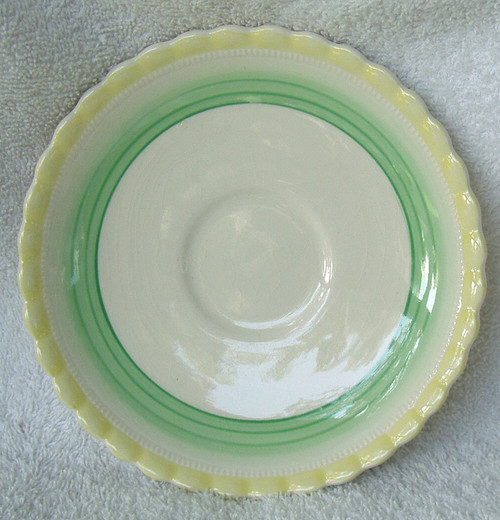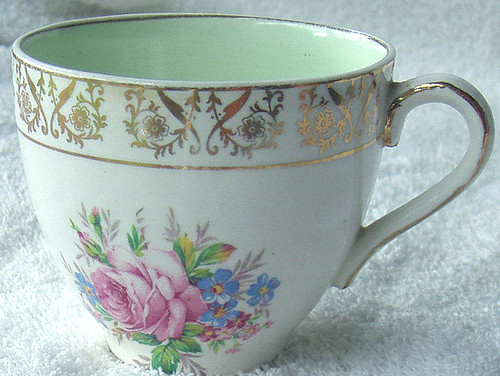Yet more of our beloved family heirloom and collected Meakin chinaware's, these came from the J & G Meakin works then they went across the sea to New Zealand with my grandparents and sometime later I became their "carer" until now I have decided to find new caring homes for them (kids these days don't seem to have any interest in historical English chinaware!)
This advertisement is ONLY for the teacup
Looking for the matching saucer? Try HERE
OR
Looking for the matching side plate? Try HERE
J & G MEAKIN - Teacup
Pattern: Unknown (and goodness knows we have searched over the years but never found it!)
SOL Series (391413 Registration which relates to the SOL trademark NOT the pattern)
Circa late 1930's ~ 1940's
I am going out on a limb with this date estimation, because although the SOL half sun face was used from 1912 onwards, the pattern looks to us very much in the style of 1930's ~ 1940's tableware, bordering on Art Deco and this date range fits in with my grandparents moving to NZ.
NO flowers
NO fancy artwork
NO Gold gilding at all
Lemon yellow outer teacup rim colouring with three bands of Lime Green INSIDE the teacup. Colouring is bold but not "garish", it is as though Meakin wanted to produce a design for the times (when Art Deco was a popular choice) and yet, not go overboard with their design.
While not in the class of your fancy "show pony" teasets from Paragon, Aynsley or Royal Albert to name a few, the design is unusual and as an aside, those are very Australian colours!
Probably originally sold as a low cost piece from J&G Meakin, due to the less number of hours taken in the decorative work BUT it may also be that this lack of design intricacy and the lack of gold gilding was also intended by Meakin because it is possible this pattern was produced during WWII years when the British Government placed very severe restrictions on potteries producing fancy china. The government wanted those pottery workers to instead be helping with the war effort and actively discouraged the pottery industry during those war years. Many potteries closed down during WWII and never reopened because of the harsh restrictions placed upon them by the Wartime Concentration Scheme.
Hand painted
Cream/White background
Pronounced lemon yellow coloured rim
Single lime green vertical line on the handle
Bands of lime green inside the teacup
Measurements: 91mm diameter
COSMETIC CONDITION:
I have four teacups left and the condition of each is very similar, so the observations directly below relate to ALL of the teacups and this is followed by any distinctions between cups
It is unrealistic to expect there to be no flaws and I have listed anything I observed in the following description
COMMON TO ALL TEACUPS:
NO cracks
NO chips
NO discolouration to the artwork - the artist has used bright colours (as opposed to pale tones) which to this day remain vivid but not overly so.
ALL cups have a tiny little 'dot' here and there, like a little bump UNDER the glaze. These are very small and they are cetainly not chips or other damage after they left the factory. You need to look very closely to find these 'bumps' but they do exist.
One teacup (look at the first photograph, this is the teacup and the brown dots are to the left of the photograph/rim area) has a couple of tiny little brown/black dots up near the top rim (in the yellow coloured area) and no matter what, I cannot lift these marks. To the touch there is nothing (no roughness which would indicate glaze damage) just these little dots which don't want to leave home! Looking at them closely under magnification, it does appear (like the dots/bumps mentioned above) that these may have been there since the time they were made.
I do get the overall impression that these teacups (in particular) were made by a lesser skilled pottery worker, the clay was perhaps not clean enough and had imperfections in it. As mentioned above, if indeed these were made during wartime, the J & G Meakin pottery works would have been under intense pressure due to the British Government limiting designs, staffing and prices they could ask for their wares - from the Government's perspective, ALL efforts of the British public should be the war effort, not in the pottery industry.
HERE IS THE TWIST THOUGH ....
Although the Saucers and Side Plates show extensive light glazing, these teacups do NOT exhibit any crazing
A bit strange because the teacups often show crazing first (hot tea, cold water washing tends to stress the glaze a bit)
I have carefully inspected all teacups we have left and NOT ONE has crazing showing (also with the wet test)
I did have other teacups (which have been sold already) but of those, only one did have crazing - remarkable! We do not waste anything and that one teacup with crazing (not offered here) now has a nice little plant growing in it!
There are no further comments specific to any particular teacup
BACKSTAMP DETAILS:
As is very common with English china teacups, the markings/backstamp is 'minimalist' in nature - often they will just have ENGLAND impressed into the teacup base
These teacups are a slight variaton on that theme, with each teacup having impressed into the base
J&G MEAKIN
ENGLAND
No artist marks are apparent

















